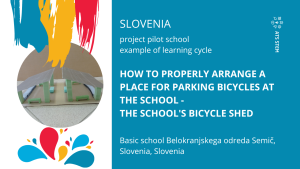Description
During the implementation of the stem learning cycle, the 8th grade students solved step by step a selected real problem on the topic of sustainable mobility: How to properly arrange a place to park bicycles or the school bicycle shed? The problem was selected at class level based on a set of written concrete problems of the learners that affect their arrival at school in a sustainable way.
Activities were first carried out in the introductory lessons to create performance criteria for the ability to solve problems at class level. This was followed by activities in maths lessons to determine students’ prior knowledge of sustainable mobility, and research and investigations into the average carbon footprint of the group and class according to the type of transport the students use most on their way to school. In terms of engineering and technology, students first formulated the criteria for setting up the school’s bike shed at the group level, followed by selecting and formulating the criteria for the grade level. In groups, students created a plan and made models of the bike shed. This was followed by a presentation of the models made, an evaluation by the students according to performance criteria, a record of suggestions for improvement and the selection of two grade-level models of the bike room. The STEM learning cycle ended with an activity during the class lesson to discuss whether the chosen solution (selected models) is feasible and to whom and when the students can present the chosen solution to the problem.
During the implementation of the stem learning unit, there were also activities for self-assessment of problem-solving skills based on set criteria.
Sustainable Development Goal n° 11: Sustainable Cities and Communities
![]()
Language
Video
Files



